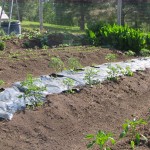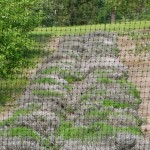by Catherine Haug
Published June 8, 2009;
- Updated October 12, 2009 (added tip on seedless melons)
- Updated June 19, 2009 (added Fertilizing with human waste);
- Updated June 24, 2009 (added tip to Protect bush beans from birds).
- Updated July 2, 2009 (moved pest control ideas to Tips: Natural Pest Control in the Garden post)
As a first time gardener, I keep my eyes and ears open to tips on gardening. Here are a few I’ve picked up this last week. If you have any gardening tips to add, send them my way and I’ll add them to the post.
Seedless melons
This tip comes from David Brown of Kalispell:
My garden did well this year. Harvested 8 cantaloupe from the one hill I planted this year. Also harvested one nice-sized seedless watermelon in late August. Didn’t realize I should have had a hill of seed-producing watermelons nearby to pollinate the seedless melon.
Fertilizing with human waste
June 19, 2009
Jean H. sent me an interesting short article on fertilizing with urine (How to Use Urine as a Fertilizer). She writes:
I have started this procedure – will let you know if I see a difference. I call it recycling my vitamins.
One of the topics that will be addressed in our upcoming slideshow: Root Cellars, Greenhouses & Gardens, is composting human waste (humanure). The following summary is from The Humanure Handbook, by Joseph Jenkins.
- First you build a double compost bin, about 5′ square and 4′ high’. Using scraps of heavy-duty metal mesh, or wooden pallets makes this construction easy.
- Then you construct a simple “toilet” consisting of a bench with a hole, and attach a toilet seat and lid. Place a bucket under the hole to collect the waste.
- Each time you use this toilet, add a small handful of slightly damp, partially composted leaves.
- When the bucket is full, add it to one side of your compost bin, along with kitchen scraps and yard debris.
- Allow the bin to compost for at least 1 year after it is full, to age. It’s advisable to cover it with a good non-weedy mulch, to insulate the bin and allow it to reach the high thermophilic temperatures needed to kill pathogens.
- Meanwhile, start filling the second bin.
Tips Moved to Natural Pest Control Post
In order to keep all the pest-related tips together, I’ve moved the following to Tips: Natural Pest Control in the Garden:
- Keep flies off lettuces
- Protect bush bean sprouts from birds
Plant flowers in your vegetable garden
This tip came to me from Celia Mildren via Annie Guerrant (Celia died a year or so ago). Celia mentored many gardeners over the years; the Daily Inter Lake even did a full page feature on her before she died, with an emphasis on her love of gardening and mentoring. I’ve known her most of my life, from when I first started going to the Lutheran Church in Swan River, which was roughly across the road from her home.
Celia always emphasized the importance of including flowers with different bloom times in your garden, to encourage pollinators and pest controllers to work in your garden. Among her favorites are violas, hollyhocks, and iris. (This photo, by Edd Blackler, is of lavender in the Guerrant’s orchard, as seen through their deer fence).
Jean H. just gave me some sunflower starts, so I’ll be planting them nearby my raised bed. And I have violas volunteering all over my yard. I’m off to a good start!
French Intensive Gardening

Another interesting tip came from photographing the Guerrants’ garden for our root cellar and gardens slide show. Their garden uses French Intensive Gardening technique. It is sited on a slope, with non-fixed raised beds terracing down a slope, and richly fertilized with composted steer and llama manure.
The technique requires extra-deep soil preparation, using a double-digging technique. It results in richly fertile low mounds that support very close planting. (Photo by Edd Blackler)
Here are a few websites on this topic:
